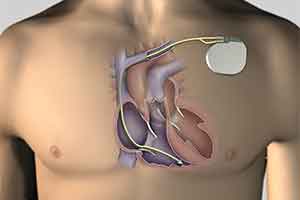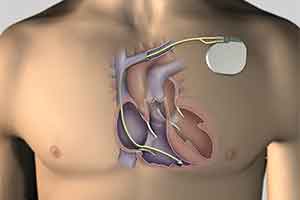DANISH No Overall Survival Benefit with ICDs in Non-Ischemic Heart Failure

 Placement of an implantable cardioverter-defibrillator (ICD) in patients with non-ischemic systolic heart failure did not improve overall survival compared to usual clinical care – although a secondary outcome, risk of sudden cardiac death, was halved with ICD placement, according to new research reported here.
Placement of an implantable cardioverter-defibrillator (ICD) in patients with non-ischemic systolic heart failure did not improve overall survival compared to usual clinical care – although a secondary outcome, risk of sudden cardiac death, was halved with ICD placement, according to new research reported here.
Results of the DANISH trial, presented at ESC Congress 2016, with simultaneous publication in the New England Journal of Medicine, suggest a caveat to both European and American Heart Association guidelines which recommend ICDs for all heart failure, noted study investigator Lars Kober, MD, from Rigshospitalet, Copenhagen University Hospital in Copenhagen, Denmark.
“Prophylactic ICD implantation is a class 1 recommendation in patients with heart failure and reduced left ventricular systolic function in both European and American guidelines,” he explained. “However, the evidence is much weaker for patients with non-ischemic aetiology. Until now, there has been the limited data on ICDs in this population, and our trial fills that gap by suggesting ICDs should not be routinely implanted in all patients with systolic heart failure.”
DANISH (which stands for DANish randomized, controlled, multicenter study to assess the efficacy of Implantable cardioverter defibrillator in patients with non-ischemic Systolic Heart failure on mortality) included stable patients with chronic, non-ischemic, symptomatic heart failure.
A total of 560 control patients were randomised to receive usual care (which included guideline-recommended medication including beta blockers, renin-angiotensin inhibitors, and mineralocorticoid-receptor antagonists), while 556 patients were randomised to receive an ICD.
There was an equal proportion of patients (58%) in both groups who also needed cardiac-resynchronization therapy (CRT). This was delivered via biventricular pacemakers in the control arm, and via a device combining CRT and ICD in the ICD arm.
After a median follow-up time of 67.6 months, the primary outcome of death from all causes occurred in 21.6% of the ICD patients and 23.4% of the controls – a non-significant difference (hazard ratio [HR] 0.87; 95% confidence interval 0.68 to 1.12; P=0.28).
Sudden death, a secondary outcome, occurred in 4.3% of the ICD patients and was almost doubled (8.2%) in the control group (HR 0.50; 95% CI 0.31 to 0.82; P=0.01).
The results were independent of whether or not a patient received a CRT device, but there was an important interaction with age, said Professor Kober.
“Patients younger than 68 years of age had a significant reduction in all-cause mortality if they received an ICD (HR 0.64; 95% CI 0.45 to 0.90, P=0.01), suggesting that younger patients may have a survival benefit with ICD implantation.”
Device-related infections occurred in both groups, since 58% of the controls had received a biventricular pacemaker. However, in patients not receiving CRT there was an excess risk of device infection in the ICD group (5.1% vs. 0.8% in controls; HR 6.35; 95% CI 1.38 to 58.87; P=0.006). Inappropriate shocks are also another risk associated with ICDs, and these occurred in 5.9% of the ICD group.
Current American Heart Association guidelines include ICD implantation as a class 1A recommendation for primary prevention of all-cause mortality in patients with symptomatic systolic heart failure – with no differentiation between patients with ischemic and non-ischemic aetiology, while European guidelines have a class IB recommendation specifically for patients with non-ischemic heart failure, he explained.
“Guidelines are based on multiple studies and ICD treatment should still have a class 1A recommendation for prevention of sudden cardiac death in non-ischemic heart failure also. However, patients with a high risk of non-sudden death may not benefit, and age should be an important factor in the decision to give an ICD, along with comorbidities,” he concluded.
Source: European Society of Cardiology (ESC)
Full bibliographic information:
Defibrillator Implantation in Patients with Nonischemic Systolic Heart Failure
New England Journal of Medicine, August 28, 2016

